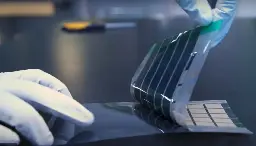Scientists develop mega-thin solar cells that could be shockingly easy to produce: ‘As rapid as printing a newspaper’
Scientists develop mega-thin solar cells that could be shockingly easy to produce: ‘As rapid as printing a newspaper’

finance.yahoo.com
Scientists develop mega-thin solar cells that could be shockingly easy to produce: ‘As rapid as printing a newspaper’

Scientists develop mega-thin solar cells that could be shockingly easy to produce: ‘As rapid as printing a newspaper’::These cells could be laminated onto various kinds of surfaces, such as the sails of a boat to provide power while at sea.
